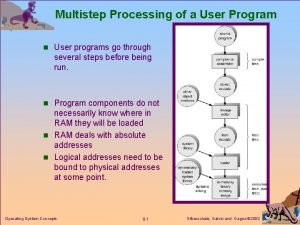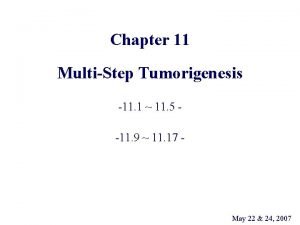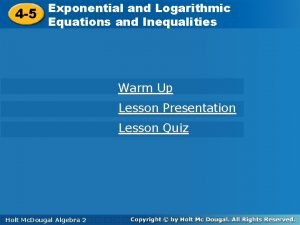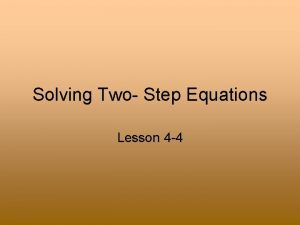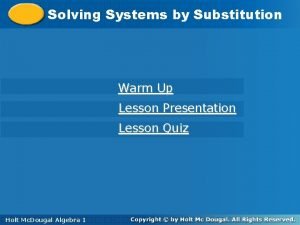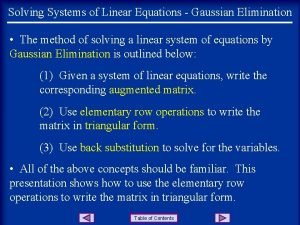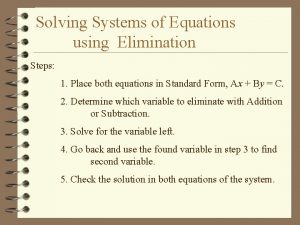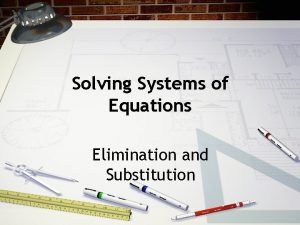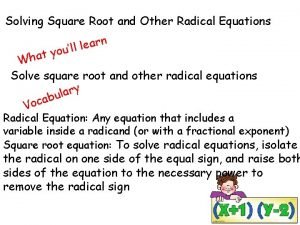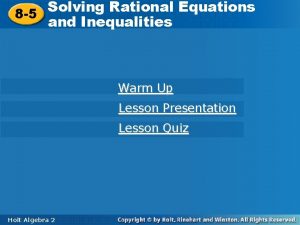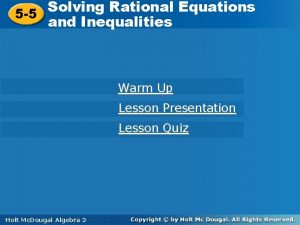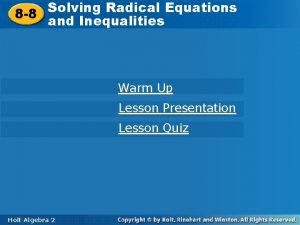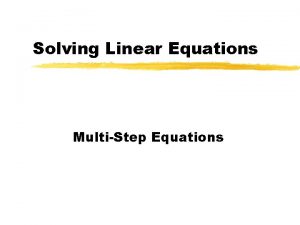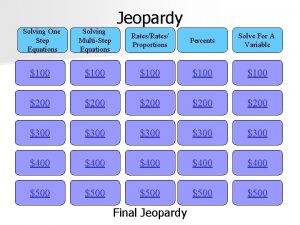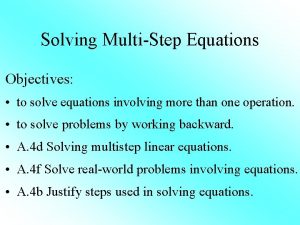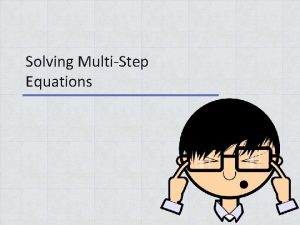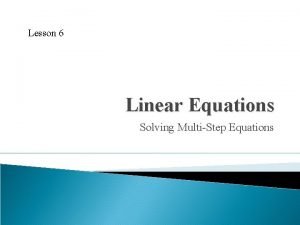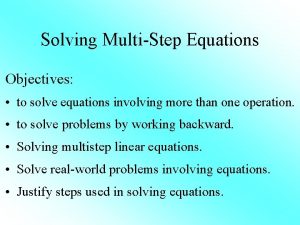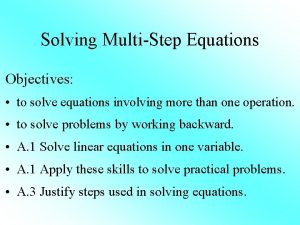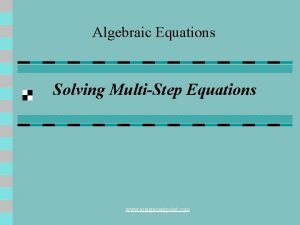10 1 Solving MultiStep Equations Additional Example 1
















- Slides: 16

10 -1 Solving Multi-Step Equations Additional Example 1: Combining Like Terms to Solve Equations Solve 12 – 7 b + 10 b = 18 12 + 3 b = 18 – 12 3 b = 6 3 3 b = 2 Combine like terms. Subtract 12 from both sides. Divide both sides by 3.

10 -1 Solving Multi-Step Equations Check It Out: Example 1 Solve 14 – 8 b + 12 b = 62 14 + 4 b = 62 – 14 4 b = 48 4 4 b = 12 Combine like terms. Subtract 14 from both sides. Divide both sides by 4.

10 -1 Solving Multi-Step Equations You may need to use the Distributive Property to solve an equation that has parentheses. Multiply each term inside the parentheses by the factor that is outside the parentheses. Then combine like terms.

10 -1 Solving Multi-Step Equations Remember! The Distributive Property states that a(b + c) = ab + ac. For instance, 2(3 + 5) = 2(3) + 2(5).

10 -1 Solving Multi-Step Equations Additional Example 2: Using the Distributive Property to Solve Equations Solve 5(y – 2) + 6 = 21 5(y) – 5(2) + 6 = 21 5 y – 4 = 21 +4 5 y 5 Distribute 5 on the left side. Simplify and combine like terms. + 4 Add 4 to both sides. = 25 5 Divide both sides by 5. y=5

10 -1 Solving Multi-Step Equations Check It Out: Example 2 Solve 3(x – 3) + 4 = 28 3(x) – 3(3) + 4 = 28 3 x – 5 = 28 +5 3 x 3 Distribute 3 on the left side. Simplify and combine like terms. + 5 Add 5 to both sides. = 33 3 Divide both sides by 3. x = 11

10 -1 Solving Multi-Step Equations Additional Example 3: Problem Solving Application Troy has three times as many trading cards as Hillary. Subtracting 9 from the number of trading cards Troy has and then dividing by 6 gives the number of cards Sean has. If Sean owns 24 trading cards, how many trading cards does Hillary own?

10 -1 Solving Multi-Step Equations Additional Example 3 Continued 1 Understand the Problem Rewrite the question as a statement. • Find the number of trading cards that Hillary owns. List the important information: • Troy owns 3 times as many trading cards as Hillary has. • Subtracting 9 from the number of trading cards that Troy owns and then dividing by 6 gives the number cards Sean owns. • Sean owns 24 trading cards.

10 -1 Solving Multi-Step Equations Additional Example 3 Continued 2 Make a Plan Let c represent the number of trading cards Hillary owns. Then 3 c represents the number Troy has, and 3 c – 9 represents the number Sean owns, which 6 equals 24. Solve the equation 3 c – 9 = 24 for c to find the 6 number of cards Hillary owns.

10 -1 Solving Multi-Step Equations Additional Example 3 Continued 3 Solve 3 c – 9 = 24 6 (6)3 c – 9 = (6)24 6 Multiply both sides by 6. 3 c – 9 = 144 3 c – 9 + 9 = 144 + 9 Add 9 to both sides. 3 c = 153 3 3 c = 51 Hillary owns 51 cards. Divide both sides by 3.

10 -1 Solving Multi-Step Equations Additional Example 3 Continued 4 Look Back If Hillary owns 51 cards, then Troy owns 153 cards. When you subtract 9 from 153, you get 144. And 144 divided by 6 is 24, which is the number of cards that Sean owns. So the answer is correct.

10 -1 Solving Multi-Step Equations Check It Out: Example 3 John is twice as old as Helen. Subtracting 4 from John’s age and then dividing by 2 gives William’s age. If William is 24, how old is Helen?

10 -1 Solving Multi-Step Equations Check It Out: Example 3 Continued 1 Understand the Problem Rewrite the question as a statement. • Find Helen’s age. List the important information: • John is 2 times as old as Helen. • Subtracting 4 from John’s age and then dividing by 2 gives William’s age. • William is 24 years old.

10 -1 Solving Multi-Step Equations Check It Out: Example 3 Continued 2 Make a Plan Let h stand for Helen’s age. Then 2 h represents John’s age, and 2 h – 4 represents William’s age, 2 which equals 24. Solve the equation 2 h – 4 = 24 for h to find 2 Helen’s age.

10 -1 Solving Multi-Step Equations Check It Out: Example 3 Continued 3 Solve 2 h – 4 = 24 2 (2) 2 h – 4 = (2)24 2 2 h – 4 = 48 2 h – 4 + 4 = 48 + 4 Multiply both sides by 2. Add 4 to both sides. 2 h = 52 Divide both sides by 2. 2 2 h = 26 Helen is 26 years old.

10 -1 Solving Multi-Step Equations Check It Out: Example 3 Continued 4 Look Back If Helen is 26 years old, then John is 52 years old. When you subtract 4 from 52, you get 48. And 48 divided by 2 is 24, which is William’s age. So the answer is correct.
 List of goals to set for yourself
List of goals to set for yourself Multistep processing of a user program
Multistep processing of a user program Multistep tumorigenesis
Multistep tumorigenesis Clausola multistep
Clausola multistep 4-5 exponential and logarithmic equations and inequalities
4-5 exponential and logarithmic equations and inequalities Unit 5 polynomial functions homework 2
Unit 5 polynomial functions homework 2 Unit 4 lesson 4 factoring to solve quadratic equations
Unit 4 lesson 4 factoring to solve quadratic equations Faceing math lesson 4 solving two step equations
Faceing math lesson 4 solving two step equations Solving systems of equations by substitution activity
Solving systems of equations by substitution activity Gauss matrix method
Gauss matrix method Using elimination to solve systems
Using elimination to solve systems Substitution and elimination examples
Substitution and elimination examples Solving square roots and other radical equations
Solving square roots and other radical equations Solving rational equation and inequalities
Solving rational equation and inequalities 8-5 solving rational equations and inequalities
8-5 solving rational equations and inequalities 5-5 solving rational equations and inequalities
5-5 solving rational equations and inequalities How to solve a radical inequality
How to solve a radical inequality

